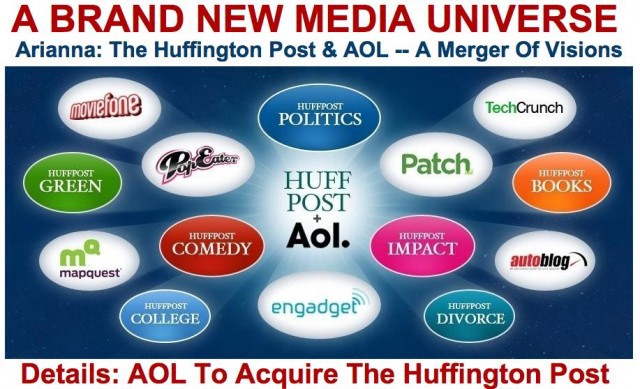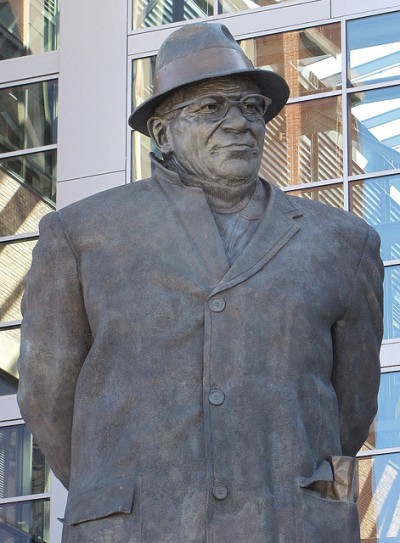Catching Up on the Worst Super Bowl Ads
Since the Super Bowl is invisible to me, I didn’t see any of its fabled advertisements — including this ad for Groupon here, that has apparently enraged everyone everywhere, what with its fairly completely misplayed sarcasm and tonedeafness and offbase first world self-mockery. (On the upside: at least now “everyone” has heard of Groupon. I guess.) The rest of the crop are rounded up here; gosh I did not miss very much in consuming important brand-related information, did I!
How Sarah Palin Tortures the Bible

With her usual vacuous brio, Sarah Palin has seized another news cycle, using an interview with the Christian Broadcasting Network to attack the Obama administration for failing to do, well, something she’d vaguely like to be done about the political crisis in Egypt. The half-term former Alaska governor assailed White House diplomacy hands for withholding reliable information about the nature of the protests and for their inability to clearly telegraph the next moves the United States will pursue in the suddenly unstable Middle East. The potential risks, she warned, are dire indeed. Washington urgently needs to determine just “who it will be that fills now the void in the government” in Egypt, she explained: “Is it going to be the Muslim Brotherhood? We should not stand for that, or with that or by that. Any radical Islamists, no, that is not who we should be supporting and standing by, so we need to find out who was behind all of the turmoil and the revolt and the protests.”
Never mind, for starters, that the protests — and the Mubarak regime’s ineffectual crackdowns on the mass dissident movement — aren’t yielding a great deal of reliable information to anyone, inside or outside Egypt. Never mind, as well, that Republican presidents going back to Eisenhower were very much devoted to standing by, with, for, around and about the Muslim Brotherhood. And never mind that even the great GOP power savant Dick Cheney, speaking at the same Young Americans for Freedom lovefest marking the centenary of Ronald Reagan’s birth, insisted that this is far from a ripe moment for public disclosure of U.S. objectives.
“There’s a reason why a lot of diplomacy is conducted in secret,” the former vice president said, before reminding the Gipper faithful, in an uncharacteristic note of realism and restraint, that the “the bottom line is, in the end, whatever comes next in Egypt is going to be determined by the people of Egypt.” Asked what he thought was going to happen in Egypt, the onetime architect of a U.S.-engineered new order in the Middle East replied simply, “I don’t know.”
But such empirical cautions are impermeable to Palin, for the simple reason that any political pronouncement by Sarah Palin is first and foremost a pronouncement about Sarah Palin. This became quite apparent when the interview with CBN reporter David Brody turned to matters of faith proper — a turn that Palin herself introduced, tellingly, when Brody asked her how she handled criticism from the mainstream press. “You know,” she replied…
I’m reminded so often of 2 Timothy 1:7 knowing that God does not give us a spirit of timidity or of fear, but he gives us a spirit of power and love and a sound mind. A sound mind so that we can keep things in perspective. We can stay grounded, we can know what is real, we can know truth, so just calling on that verse, reminding myself over and over again what’s God promises, that gets me through the tough times.
OK, then. First off, replying to putative detractors in the American media by citing the authority of the imprisoned Apostle Paul, in the last epistle he penned from jail in Rome prior to his death, is by itself far from compelling evidence of the ability to “keep things in perspective.”
More to the point, sophronismos, the Greek phrase Paul uses here to characterize the mental outlook of the convicted Christian, and rendered as “sound mind,” more accurately translates as “discipline” or “self-control.” Its intended meaning is conveyed more sharply by its opposite term, akrasia, or self-indulgence. This, in other words, would be strike two in Palin’s gloss on Paul, since by the account of Vanity Fair’s Michael Joseph Gross, one of her most common rebukes to staffers is “I have the power to ruin you.”
As for the finding of truth, well, Palin pretty much has the inductive logic of Paul’s directive backwards here. He’s exhorting the believer — in this case Timothy, the young bishop of the Ephesians — to trust in the pre-existing truth of God, imprinted upon the faithful by the fact of their conversion. The idea here is not so much to employ divine grace to seek out truth as to draw upon the inward character of God’s truth as a repository of strength amid the early Church’s many afflictions and institutional quandaries. Nor does this point involve any recondite with biblical Greek; it’s right there in the preceding verse, 2 Timothy, 1:6 (KJV): “Wherefore I put thee in remembrance that thou stir up the gift of God, which is in thee by the putting on of my hands.”
But, as is quite oddly plain in Palin’s later description of her devotional routine to Brody, she’s not in the habit of relying on divinely sanctioned truth to curb the deceptive dictates of the human ego. Rather, the disciplinary strictures of scripture seem chiefly to serve in Palin’s world as an ever-encouraging set of offstage prompts, goading the persecuted media victim into ever-greater acts of self-assertion. Indeed, as is the case with her critique of the media, reading the Bible’s word is pretty much a given, something she can airily stipulate as fait accompli — or as she curiously puts it here, something she intends to start doing, in that same vague future in which her remarks on Egypt policy might also make sense:
]Time is our most precious resource. How we choose to spend time I think is a reflection on what’s most important to us. I am going to read my Bible every day. I am going to dig in there and seek God’s wisdom and direction in every step that I take so I prioritize time to make sure that that daily devotion is available. And I will participate in that. But it’s not just carving some time out of the day to read the Word and to journal what you know, I believe I am gaining from the Word, but it is ongoing minute by minute asking God for the strength, for the direction for, He says we can ask for favor, I ask for favor in situations so that I can continue down the path. And it’s the most important thing in my life, my faith, so I prioritize to make sure that I’m spending the time that I need to stay all geared up.
This, to put things mildly, is a weirdly cursory approach to “the most important thing in my life.” Note, first of all, the persistent recourse to the future tense in her reply : “I am going to read my Bible…”; “I am going to dig in there….”; “I will participate….”
Then, more crucially, there’s the appeal to a divine authority beyond the word — the notion of an experiential awareness of God’s “favor” more commonly associated with prophecy than with the routines of daily observance and fellowship. The rhetoric of prophecy is indeed where the action is — at least for any leader of Palin’s national ambition who also needs to galvanize a base of evangelical supporters. It is, first of all, a kind of faith that the exponent can define largely as she sees fit — hewn in a deeply personalized vision of God’s favor, long on individuality (“ongoing minute by minute asking God”), and short on public accountability. Prophets are also, far from incidentally, among the most persecuted and misunderstood emissaries of God’s will, in both the Old Testament and the New. So the mantle of prophecy permits Palin to continue pursuing her own lusty brand of culture warfare on her own preferred Sarah-centric terms. This, remember, is the person who thought the appropriation of the term “blood libel” was an appropriate and measured response to the charge that she had infected American political discourse with violent imagery.
Oddly enough, later in 2 Timothy, Paul advises his young charge to guard against “profane and vain babbling” (2:16) as both Paul’s own captivity winds down and the last judgment approaches. The trick, Paul writes, is to “continue thou in the things which thou hast learned and hast been assured of …. And that from a child thou hast known the holy scriptures, which are able to make thee wise unto salvation through faith which is in Jesus Christ.” (3:14–15) What’s more, he intimates that the distinction that Palin seeks to draw between the written Word and God’s personal favor is largely illusory: “All scripture is given by inspiration of God, and is profitable for doctrine, for reproof, for correction, for instruction in righteousness: That the man of God may be perfect, thoroughly furnished unto all good works.” (3: 16–17) We can only hope that, someday, Sarah Palin may find time in her busy schedule to get around to journaling that.
Chris Lehmann is our religion columnist.
Innovative Woman Cartoonist Turns Out to be Just Another Man
One of the few female editorial cartoonists in the world, Austria’s Rachel Gold, an immigrant from Israel… turns out to be an Austrian man.
Tina Fey Amuses, Harrows
The Tina Fey thing in the New Yorker today — subscription only, cheapos! — is actually great. It’s a funny, tangled little thing that still feels raw and a little frightening! True fact: “Network executives really do say things like ‘I don’t know. I don’t want to fuck anybody on this show.’”
Das Racist on the Nature of God

Das Racist (America’s best rappers? You decide) recently played at Carleton College and of course hijinks ensued: “After their show I walked up to Victor who was being accosted by fangurls and I was like, ‘Hey these chicks are weird come hang out with my friends our hotel room is right by yours’ and he said, ‘Okay’ so we went back to our hotel and did a bunch of fun and weird stuff like playing chicken in the pool and watching The Nanny and four-way spooning and jumping on beds.” Naturally. And then an interview ensued on the nature of philosophical problems with Das Racist’s Victor Vazquez: “Q. Can god make a boulder so big that god cannot move it? A: That’s why God doesn’t exist.”
The World's Most Exciting New Concert Hall
Miami Beach now, unexpectedly, has two of the most exciting buildings in the world. The first was a parking garage, by Herzog & de Meuron, which serves little public benefit except beauty. (Though it is a boon to the wedding and party industry, and it also serves much private benefit to its owner, and no doubt it will be converted entirely into rich people lofts in the future.) That the owner calls it a “civic space” is pretty ridiculous; his penthouse is on the roof of the building and the flat rate for parking is $15. But the new home of the New World Symphony, reviewed today by Alex Ross, a few blocks away, is out of this world. I’m not a Frank Gehry fan in general but the hall is designed entirely to engage and invite the public; it fights every problematic issue of the death of classical music and the cloistering of its audience. Each night during performances, the exterior broadcast of the music and video from inside plays to packed standing-room-only crowds. And you think: wow, they actually got it! To watch an older arts institution prioritize innovative ways to create and engage new audiences is fantastic.
AOL + HuffPo: What Does It Mean?

AOL’s purchase of the Huffington Post for $315 million is fascinating. It comes directly on the heels, for one thing, of a Goldman Sachs assessment issued last week, with a “neutral” rating and the headline “still waiting for the promised turnaround.” (It notes that AOL’s ad revenue was down 27% and 29% from the previous year in quarters three and four.) You spoke a little soon, Goldman Sachs! Now AOL has inventory to sell! And HuffPo has content from elsewhere to suck in to sell against! What a morning — Arianna Huffington and AOL honcho Tim Armstrong are touching each other! AOL’s publicist and Arianna’s publicist are integrating! Let’s look deeper!
It’s almost like AOL is just a conduit through which middle American money passes to coastal elites.Mon Feb 07 12:43:18 via web
Dana Vachon
danavachon
Business
First, the money! Huffpo took in $30 million in 2010, give or take, with 203 employees. They expect to make $60 million in 2011. (Outside investment in the company to date has been $37 million.) Meanwhile? AOL’s local news network-thing, Patch, is going to cost AOL $160 million in 2011.
For comparison to some other media organizations?
FYI total operating budget of NPR and PRI is less than $12 million … HuffPo = 26 x larger, still no non-endowment original reportingMon Feb 07 05:15:24 via web
Gideon Yago
gideonyago
What’s rather shocking is that the New York Times said of this purchase that AOL is “betting on news.” Why an actual news-gathering organization thinks that is bizarre. They have confused content with news.
Editorial
Arianna Huffington: editor in chief! She is supposedly “moving to New York,” and will be the honcho of the “Huffington News Group.” This, among other things, makes her the boss of Michael Arrington at Techcrunch and Joshua FruhlingerTopolsky [Ed Note: LOL! Crazy morning, crazy name substitution!] at Engadget — as well as of Black Voices, Mapquest and Moviephone!
How long till the first Arrington/Huffiington throwdown? I give it two weeks.Mon Feb 07 05:34:59 via web
Elizabeth Spiers
espiers
Right? It’s a rich new world for intrepid media reporters.
Context
The second big media merger in recent months, after the wild mating of The Daily Beast with Newsweek, this precedes an expected and very strange forthcoming merger, we hear rumors, between one long-time (and long-suffering) large website with an unlikely new owner. This unbridled content-world mergermania will most likely strengthen the new companies — except in the cases where one party becomes a giant stone around another’s neck. (A potential outcome for The Daily Beast with Newsweek, sure! Far less so than for HuffOL. AOLHuff. I don’t know — please work on that.) On a smaller level, one that we care about: all these mergers will most likely put a fair number of people out of work. Oh well, brave new world.
Finally, Arianna’s longstanding AOL email address comes in handy. #seriouslyshestillusesitMon Feb 07 05:47:46 via Twitter for iPhone
Maureen O’Connor
maureenoco
That is a true thing.
We’ll give our own publisher the last word.
AOL just bought HuffPo, so I guess AOL doesn’t have to make its own content farm now (bc they just bought one, in case you didn’t get that).Mon Feb 07 06:06:27 via web
David Cho
davidcho
How Much Super Bowl Is Too Much Super Bowl?

On Thursday morning, I went to the Paley Center for Media — which used to be the Museum of Television and Radio, and still kind of is, although it’s now called the Paley Center for Media — and was brought down into a basement dubbing room, where I watched something that was long thought not to exist. It’s a tape of the CBS broadcast of Super Bowl I, which was played in front of roughly 61,000 spectators and 30,000-plus empty seats at Los Angeles Memorial Coliseum, on January 15, 1967. Since then, the game has been famously unseen and unseeable, outside of some sideline footage shot by NFL Films.
Neither CBS nor NBC retained a copy, and given that video recording devices at the time were universally of the giant-steel-box-that-gets-really-hot variety — “This is the portable model,” the Paley Center’s Doug Warner said, standing next to an Ampex recorder the size, shape, and vague taupe-ish color of a refrigerator resting on its back — it was presumed that there were no taped copies of the first Super Bowl. It turned out that there was indeed a taped copy of it — on a pair of heat-warped two-inch reels that had lived in an attic for nearly four decades, and which had been restored and converted to Beta PS tapes by a New Jersey company called Specs Bros. The tapes were at the Paley Center, and the footage that had long been thought lost was — after Warner cued everything up, and after a few nauseous seconds of rolling images and sizzling static — there in surprisingly vivid color, on a small monitor.
Even by the usual standards of watching very old television, watching Super Bowl I was a jarring, beguiling, backhandedly poignant experience. In what was either an attempt to conserve tape (Farmer’s hypothesis) or a proto-TiVo maneuver (mine), the person who recorded the tape cut out the commercial breaks and otherwise tried to take up the slack between plays. As Sean P. noted in the comments of last week’s column, a football game seen stripped of its non-football elements is almost avant-garde in its disorienting, re-contextualized violence — there’s a brief fury of grunting and shoving and footballian activity, then another, and another. The laconic sportscasting style of the day — roughly half of the play-by-play is comprised of ellipses, the color commentary is colorless — added to the strangeness of this version of Super Bowl I. The score and game clock, among other constants of the contemporary televised football experience, surface only briefly and seemingly at random. A vast shadow passes over the field when a blimp floats overhead.
At the end of the tape, seemingly secure that he’ll have enough tape, the recorder eases off on the cuts. The Chiefs, down four scores with five minutes remaining, gather for a confoundingly long huddle. The commercials, unhurried and earnest, finally make their way into the narrative — a McDonald’s ad takes the almost-touching gambit of touting the quality of the McDonald’s double burger, made of beef “ground and delivered fresh, by the finest meat men in town.” By that point, the game is more or less over. When it is finally more over than less, Pat Summerall — his mellow, familiar old guy voice incongruously issuing from a young, clammy, heavy-lidded face — stands outside the Packers locker room and interviews NFL commissioner Pete Rozelle. Rozelle, grinning and a little unctuous, tells Summerall that he has high hopes for the NFL/AFL Championship in the future, and breaks the news that AFL and NFL teams will begin playing interleague preseason games next year.
And then the broadcast is over, two-and-a-half hours after it started. The first Super Bowl, which would only retroactively be given that name, was not reviewed terribly kindly — “Mixed to negative,” Paley Center curator Ron Simon says — and was not even the biggest thing to happen on television that day. An hour after the game ended, the Rolling Stones went on the Ed Sullivan Show and sang “let’s spend some time together” where they generally sung “Let’s Spend The Night Together.” Art Carney was on the cover of TV Guide that week, and the recommended sports programming in that issue was a Harlem Globetrotters game played on an aircraft carrier.
Rozelle’s optimism for the Super Bowl’s success was not unfounded, as it turned out, but watching the first Super Bowl amid the thunderous maelstrom of Super Bowl week — the sponsored hype and garishly branded Super Bowl parties and giddy parades of consumption-related statistics — made the experience stranger still. Unswaddled from its blanket of synergies and pomp and the other impacted monetization strategies that encase it, even the Super Bowl is actually a fairly small thing. This year’s Super Bowl broadcast will be nearly 90 minutes longer than the first one, padded by 30 minutes of artless technophiliac retardo-pop at halftime — “In other Peas-related news: apl.de.ap has shaved ‘XLV’ into his scalp, and Taboo has a book coming out” — and nearly 50 minutes of commercials. Super Bowl I’s homemade-looking yardage markers have been brought up to state of the neon-foam art; a helpful yellow line will demarcate first downs; there will be that fucking football robot, doing the things it does. But at the center of it, still, is a football game of regulation length, played on a regulation field.
In comparing the two games, there’s a certain amount of adjusting for inflation that needs to be done, for rhetorical and presentational excess and generalized ridiculousness. There’s also a very much to-be-resisted tendency towards implying some bygone yeoman integrity on the former game’s more human-scale athletes, a risk of finding too much in their Old America faces. The players’ mushed-up factory-floor mugs and earnest crewcuts are not, of course, any more or less virtuous than the different styles on their bearers’ contemporary analogues, and the fact that the old players were paid far less, relatively and absolutely — and wore less-effective protective gear, and wouldn’t win the right to free agency for another two-plus decades — doesn’t make the first game any purer, its violence any less violent, or the exploitiveness of its 100-yard workplace any more quaint. That sort of sentimento-historicism is usually associated with baseball’s moist bard types, but George Will has plenty of tears-of-testosterone counterparts in football. Bullshit being bullshit, it’s easy to know what to avoid in comparing the two games. But there is one thing that makes watching Super Bowl I less exhausting than watching a contemporary Super Bowl — its size.
There are only so many smart ways to talk about sports, and they have never been the more popular ones — the child’s treasury of dated, hurried, ill-considered Super Bowl prose at Deadspin indicates this, and I can report that in the pre-game show to the game that was not even yet the Super Bowl, a commentator compares a game between the AFL and NFL champs to the fucking Civil War. All those martial NFL Films soundtracks are the purest camp at this point, which is why you hear them under commercials for gameday-tough air fresheners as much as you do under actual highlights, but while the corniness of all this pomp is plain, it accretes all the same. Year after year, it has added up, and the Super Bowl has risen into a ripe, shiny bloat in its course.
This is not exactly news, I know, but I’ve always believed that the bloat — more than a game encased within it, which either will be fun to watch or won’t, but will still feature four 15-minute quarters — is the thing that puts people off about the game. The week of pump-it-up-when-you-don’t-even-mean-it media coverage, all those thimblefuls of glib microanalysis, the leering reach for the nearest SEO-able semi-scandal — Did Player X RIP Player Y (VIDEO)? — all seem longer and louder and more desperate each year, and they will send you flipping to the Puppy Bowl if you’re even remotely so inclined. The percentage of the Super Bowl broadcast given over advertisements expands exponentially — last year’s Super Bowl featured seven more minutes of commercials than did 2001’s. But this is what happens, it’s what the market does: big things get bigger.
But the cellular division that powers this sort of overgrowth is not necessarily healthy, and long ago shaded towards decadent-unto-metastatic. That the Super Bowl is too hyped, too rich and too leveraged and branded and expensive and excessive is palpable, even in the corners most excited for it. It looks strong, of course, but these are steroid muscles — puffed up, built the wrong way, grounded in things that ruin.
And so you get all this. It’s not a failure of taste that leads NFL owners — all of them owners of profitable teams, all of them beneficiaries of a television deal that pays the league $4 billion per annum — to boldly demand massive concessions from the players union because Of These Difficult Economic Times. Or that leads Sports Illustrated’s NFL hagiographist/coffee-critic Peter King to write a tone-deaf piece fretting over the prospect that commissioner Roger Goodell — “sandy-haired and fit at 51,” recipient of nearly $10 million in annual pay, point man on the owners’ plan to extract those concessions and add two regular season games (which fans don’t necessarily want) to the NFL’s already brutal schedule — might be working too hard, according to friends. Or, at the most distant pole, that led Chuck Klosterman to get up at the Varsity Letters reading series on Thursday night and extemporize to the effect that the prospect of a NFL player dying on the field is something he likes most about the game. “Think about it,” Klosterman said, tipsy off his own contrarianism, “they’re putting their lives on the line out there.” Klosterman seemed, beneath his grin and that beard and at the distance from which I regarded him, to be moved by how moved he was at the prospect, and amused at how amusing he found it.
That is all rotten, of course. But while the above are not in good taste, they are failures of perspective first and foremost. They reflect an inability or unwillingness to see beyond the self-flattery of dumb comforts and acknowledge complicated circumstances and context. Or, if you prefer, those distinct idiocies are different symptomatic presentations of the same disorder — a terminal inability to give a shit. The NFL, as it presently exists, is built to elicit this response in people — it makes emotion cheaper and easier to digest, it takes the laziest arms-length cruelties and ignorance and processes them until they are rich and filling. But the bigger the NFL makes itself — the more it gorges on synergies and succumbs to the distorting, obliterating appetites of irresponsible wealth — the more obese it becomes. The reason why the long march to the Super Bowl is exhausting — and why the entire NFL experience is increasingly obscene in an increasing number of ways — is that the NFL is not presently in shape to make a journey this long. It is too big, and getting bigger.
The people above would tell you that they care a great deal about football, and they believe they do. But their steadfast unwillingness to engage the game as what it is — a very complicated, very appealing consumer good, but one that is not without its costs — sure suggests that they can’t see it very clearly. Or, at the very least, it suggests that they’d prefer to get fat on the easy fantasies of power and imperviousness that the NFL spectacle offers to the exclusion of everything else that the game has going for it. Which is a shame, because the show around the game — the deafening, Black Eyed Peas-afflicted carnival of Super Bowl week is its apotheosis, but we’ve been wandering this ghoulish-garish midway all year long — is so much less interesting than the game itself.
The sport underneath that corn-fed load is in great health, actually — the game of football is more fascinating and intricate and enjoyable now than it has ever been, especially relative to the static sets and straight-line gruntiness of Super Bowl I. It’s complicated as hell, balances grace and violence with uncanny ease, is funny in ways intentional and unintentional, and is generally a lot of fun to watch when it’s played right. But the NFL’s seeming delight in mistaking expansion for development and bloat for growth is very bad for its heart. That is, carrying all this extra weight is bad for the vital game pumping away at the center of this fat, avid, keening monster — the strong, secret thing struggling to keep this rude beast alive.
And the year’s final pick, because why not, right? What am I going to do, finish a little further under .500? Lose to a freaking coin by a bit more than I currently am? (Yes, those are the things that will happen) But yeah, here goes:
Conference Championship Round and Overall: David Roth: 1–1 (117–120–9); King Bhumbibol The Royal Thai Baht: 1–1 (122–114–9)
Sunday, February 6
• Green Bay Packers (-2.5) vs Pittsburgh Steelers, 6:30pm — DR: Green Bay; KBTRTB: Pittsburgh
David Roth co-writes the Wall Street Journal’s Daily Fix, contributes to the sports blog Can’t Stop the Bleeding and has his own little website. And he tweets!
Photo by Jim Bowen, from Flickr.
Five Days That Took Forever

• Suggestion: Let’s regulate Facebook
• Overreaction: Oh no, a new radical Muslim Egypt!
• Connection: Congresspeople have a lot in common
• Evaluation: Britney Spears’ album covers
• Discussion: There’s a big game on Sunday, you know.
• Reception: How do writers feel about the recent attack on the memoir?
• Obsession: My 50 favorite rap songs
• Instruction: What to do when you’re invisible
• Distraction: Great web and mobile games!
• Explanation: What happened in Egypt this week
Photo by joiseyshowaa, from Flickr.
